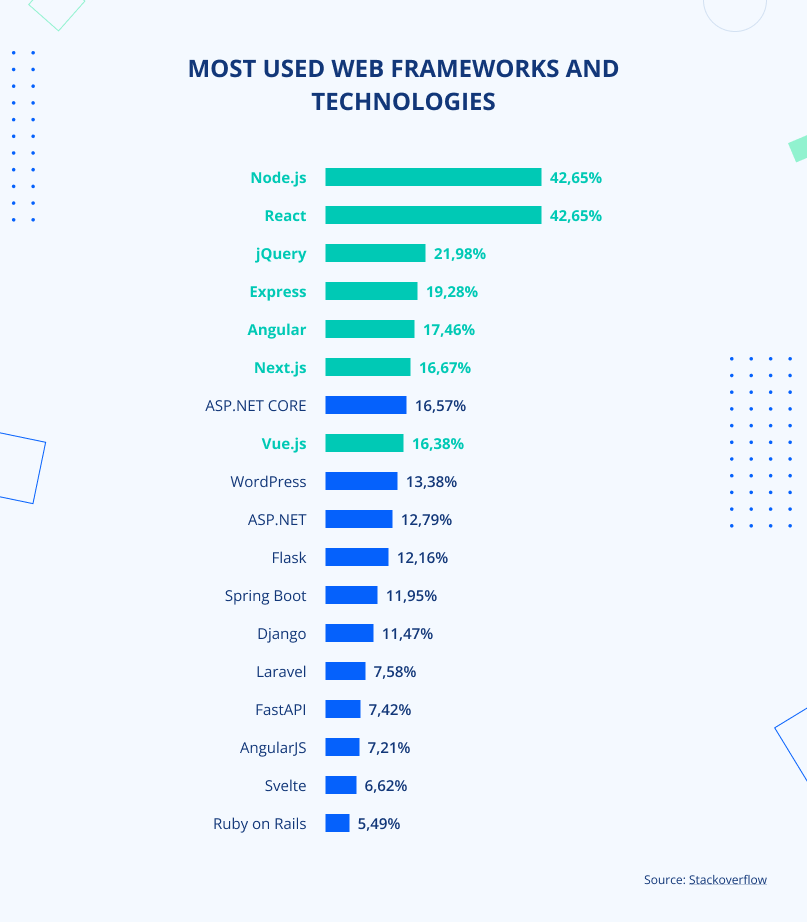Blitz News Digest
Stay updated with the latest trends and insights.
JavaScript Frameworks: The Battle of the Titans
Discover the ultimate showdown of JavaScript frameworks! Uncover the pros and cons to choose the best for your next project.
Understanding the Key Features of Top JavaScript Frameworks
JavaScript frameworks have revolutionized the way developers build web applications. Understanding the key features of these frameworks is essential for choosing the right one for your project. Among the most popular frameworks are React, Angular, and Vue.js, each offering unique capabilities that cater to different development needs. For example, React is renowned for its component-based architecture, which allows for reusable UI components, while Angular provides a complete solution with tools for routing, state management, and form handling.
Another important aspect to consider is the performance and scalability of these frameworks. Vue.js is often praised for its lightweight design and fast rendering, making it ideal for smaller projects, while Angular excels in building large-scale applications due to its robust structure. Additionally, many frameworks include built-in features such as state management libraries, testing utilities, and improved SEO capabilities, which can greatly enhance the development process. Understanding these features can help developers select a framework that aligns with their project requirements and long-term maintenance goals.

React vs. Angular vs. Vue: Which Framework Reigns Supreme?
When it comes to modern web development, choosing a framework can significantly impact the efficiency and scalability of a project. React, Angular, and Vue are three of the most popular JavaScript frameworks, each with its unique strengths and weaknesses. React, developed by Facebook, is renowned for its flexibility and the powerful component-based architecture that it offers. On the other hand, Angular, backed by Google, provides a robust out-of-the-box solution with an extensive set of features, making it suitable for large enterprise-level applications. Lastly, Vue, known for its simplicity and ease of integration, is an excellent choice for developers who prefer a gentle learning curve without compromising performance.
To determine which framework reigns supreme, it's essential to consider various factors such as performance, community support, and ease of use. For instance, while React excels in rendering performance and flexibility, it requires additional libraries for state management, which can complicate development. Angular comes with a steep learning curve, but its comprehensive features, including two-way data binding and dependency injection, make it powerful for large-scale applications. In contrast, Vue strikes a balance between performance and ease, allowing for rapid development without the overhead of a complex framework. Ultimately, the choice among these frameworks should be driven by project requirements and developer proficiency.
How to Choose the Right JavaScript Framework for Your Project
Choosing the right JavaScript framework for your project is crucial to its success, as it can significantly affect development speed, maintainability, and performance. Start by assessing your project's specific requirements. Consider factors such as scalability, team expertise, and community support. Popular frameworks like React, Angular, and Vue.js each have their unique strengths. For instance, if you're focusing on building a dynamic web application with a complex user interface, React may be a better fit. On the other hand, if you're looking for a comprehensive solution that integrates a robust routing system and form handling, Angular could be the best option.
Once you've narrowed down your choices, it's essential to evaluate the performance and learning curve associated with each framework. Examine factors such as loading speed, rendering capabilities, and ease of use. You might consider creating a small prototype or proof of concept using the frameworks you're interested in, which can provide concrete insights into their functionality and suitability for your project. Additionally, check the documentation and available resources, as comprehensive guides can significantly ease the onboarding process for you and your development team. Ultimately, making an informed decision will lead to a smoother development process and a more successful end product.